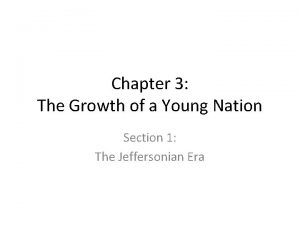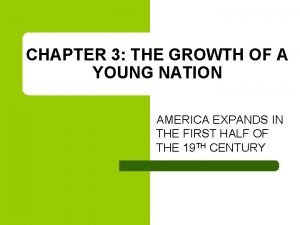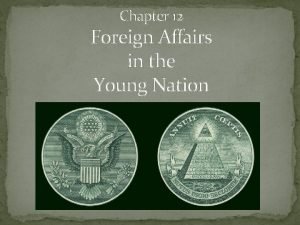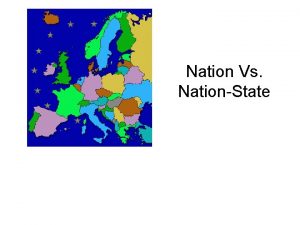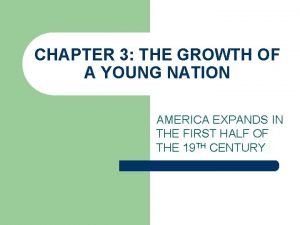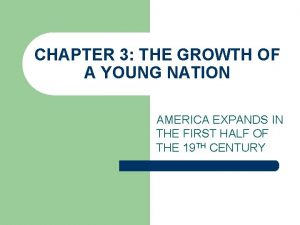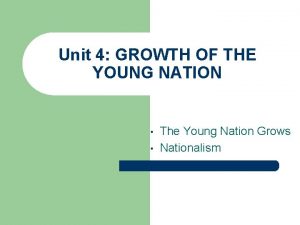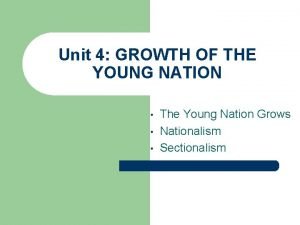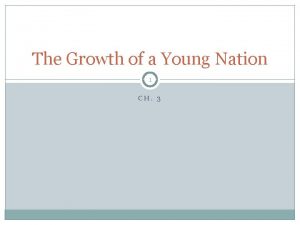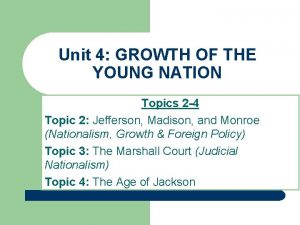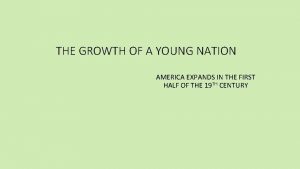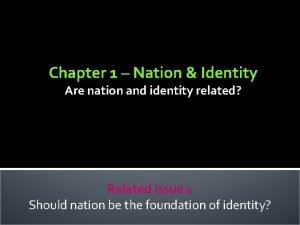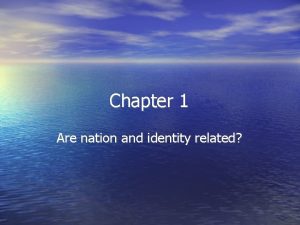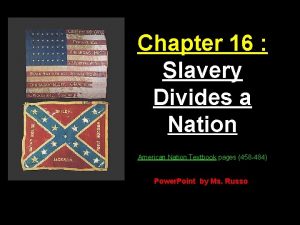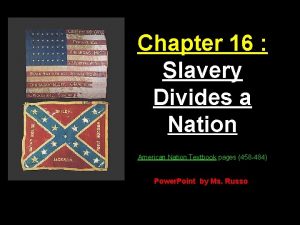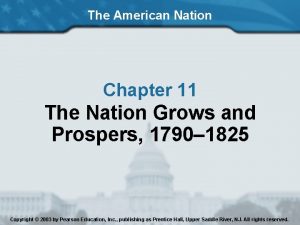Chapter 3 The Growth of a Young Nation








































- Slides: 40

Chapter 3: The Growth of a Young Nation

The Jeffersonian Era Simplified the gov’t by decentralizing its power and shrinking its size. He reduced the size of the army, lowered spending during gov’t functions, and eliminated all internal taxes. First Pres. To live in the White House 3 straight Pres. From Virginia showed the decline of Federalists influence in politics.

The Louisiana Purchase Significance-stopped the French from colonizing the area for themselves. -prevented the U. S. from having to form an alliance with Britain. -More than doubled the size of the United States. -opened up the west for expansion.


The War of 1812 Causes “Impressment”- practice of seizing Americans at sea and drafting them into the British Navy -Americans learned the British in Canada were supplying arms to the Native Americans during their battle with American settlers


Consequences of the War Three Important Results - Led to the end of the Federalists Party, whose members were against the war. - Encouraged the growth of American industries to manufacture products no longer available from Britain. - Confirmed the status of the U. S. as a free and independent nation.


The Monroe Doctrine President Monroe warned all European nations not to interfere with affairs in the Northern Hemisphere They should not attempt to set up new colonies or try to overthrow the newly independent republics The U. S. would do the same and not interfere with European affairs.



Settling the Frontier Americans pursue “Manifest Destiny” the belief that the U. S. was ordained to expand to the Pacific Ocean and into Mexican and Native American territory Additionally, this destiny was manifest, or obvious and inevitable Many reasons for moving west-abundance of land was the greatest attraction -merchants and manufacturers followed -a fresh start in the West from economic problems

Trails West Santa Fe Trail -busiest route, stretching 780 miles from Independence, Missouri, to Santa Fe in the Mexican Providence of New Mexico -Every spring from 1821 through the 1860 s, American traders loaded their covered wagons with goods and headed to Santa Fe -For the first 150 miles they traveled individually

Santa Fe Trail -After that they banded together into organized groups of 100 wagons -However, the teamwork ended abruptly when Santa Fe came into sight -After a few days of trading they loaded up the wagons with goods, restocked their animals, and headed back to Missouri

Oregon Trail Independence, Missouri, to Oregon City, Oregon -originated in 1836 when two Methodist missionaries dared to prove a covered wagon could make it to Fort Boise -Some traveled in the ‘prairie schooners’, covered wagons -However, most walked, pushing handcarts loaded with a few precious possessions, food, and other supplies -The trip took months, even if all went well



The Mormon Migration to escape persecution -played a huge role in the development of the west -Joseph Smith founded the group in 1827 in New York -Moved to Ohio and then Illinois to escape persecution -Anti-Mormon mob kills Smith, Brigham Young takes over and urges the group to move west

The Mormons -Thousands walked to Nebraska, across Wyoming to the Rockies -1847, they stop at the edge of a desert near the Great Salt Lake, where Young declared this is the place -They developed settlements and farms out of the desert by irrigating their fields -Salt Lake City blossomed out of the land previously uninhabitable



Texan Independence The mission system declined after Mexico won its independence in 1821 -Mexican gov’t offered the lands around the missions to gov’t officials and ranchers -they also encouraged Americans to settle in Texas to make the land more stable and secure -many Americans jumped at the chance to buy inexpensive land in Texas

The Texas Revolution Despite peaceful cooperation between the Americans and the Tejanos, the Mexican gov’t had problems with the cultural differences -The Americans spoke English instead of Spanish - Many of the American settlers were from the south and brought with them their slaves -Mexico had abolished slavery in 1829 and insisted the Texans free their slaves

The Texas Revolution Meanwhile, Mexican politics had become unstable -Antonio Lopez de Santa Anna was in control of Mexico -He ordered Sam Houston imprisoned for starting a revolution in 1833 - Santa Anna also took all the local power away from Texans, which angered the Texans into several rebellions - Houston returned in 1835 and decided war was the only option -Led to the Battle at the Alamo


Texas Moves Toward the Union After capturing Santa Anna at the Battle of San Jacinto River -Texans made Santa Anna sign the Treaty of Velasco, which granted independence to Texas -Most Texans wanted the U. S. to annex them into the union, but U. S. opinion was divided along sectional lines

Texas Moves Toward the Union -Southerners wanted Texas in to extend slavery -Northerners feared it would tip the balance in the Senate and prompt war with Mexico -The 1844 U. S. presidential campaign focused on westward expansion -James K. Polk was the winner, a slaveholder, who firmly favored the annexation of Texas

The War with Mexico March 1845 - the Mexican gov’t recalled its ambassador from Washington December 1845 - Texas entered the Union Events moved quickly after this towards war

Polk Urges War He believed war would bring not only Texas into the Union, but New Mexico and California as well Thus he supported Texas in its claims over the border with Mexico Texas insisted its southern border extend to the Rio Grande While Mexico maintained it stopped 100 -150 miles northeast of the Rio Grande


Polk Sends Troops He wanted to buy New Mexico and California, and settle the boundary dispute secretly He sent Louisiana Congressman John Slidell to negotiate the deal, but the Mexican gov’t refused to see him So, Polk sent U. S. troops into Mexican territory

The War Begins 1845 -John C. Fremont led an American military exploration party into California, violating Mexico’s territorial rights In response, Mexican troops crossed the Rio Grande In a skirmish near Matamoros, Mexican soldiers killed 11 U. S. soldiers Polk immediately called for war and Congress approved

New Mexico 1846 -Polk orders Colonel Stephen Kearney and his troops to march from Fort Leavenworth , Kansas, to Santa Fe, New Mexico They were met by a New Mexican party of upper-class Mexicans who wanted to join the Union New Mexico fell without a shot being fired

The Republic of California June 1846 - a group of American settlers seized the town of Sonoma Hoisting a flag that featured a grizzly bear the rebels declared their independence from Mexico Proclaiming the nation as the Republic of California Kearney joined Fremont in California, and with help from an American naval party, took control of the new Republic


America Wins the War After about a year of fighting, Mexico conceded the defeat Zachary Taylor and Winfield Scott had done damage in Mexico, winning battle after battle February 2, 1848 - the U. S. and Mexico sign the Treaty of Guadalupe Hidalgo We got the Texas border , New Mexico, and California The U. S. agreed to pay $15 Million for California, Nevada, New Mexico, Utah, most of Arizona, and parts of Colorado and Wyoming

The Borders are Set 5 years later, Pres. Franklin Pierce paid Mexico an additional $10 Million for another piece of territory south of the Gila River to secure a southern railroad route to the Pacific Ocean Along with the settlement of the Oregon Territory and the Treaty of Guadalupe Hidalgo, this purchase established the current borders of the lower 48 states

The Gold Rush January 24, 1848 - Gold is discovered at Sutter’s Mill Once the word got out, everyone wanted to head that way to strike it rich Migration to California rose from 400 in 1848 to 44, 000 in 1850 By the end of 1859, California’s population was well over 100, 000 Including Mexicans, free African-American miners, and slaves

The Gold Economy Gold financed the development of farming, manufacturing, shipping, and banking By 1855, more newspapers were published in San Francisco than in London, more books than the entire U. S. west of the Mississippi Gold Rush peaked in 1853, though mining continued throughout the rest of the decade Very little profit was made by the average miner, large businesses made the most from the actual gold Merchants were the big winners!

“Go West Young Man!” Horace Greeley, editor of the New York Tribune, had previously declared anyone who made the trip west a fool After gold was discovered, he himself made the trip in search of riches, and declared that everyone should go west In the spirit of Manifest Destiny, countless settlers heeded his words in the decades that followed
 Chapter 3 the growth of a young nation
Chapter 3 the growth of a young nation Chapter 3 the growth of a young nation
Chapter 3 the growth of a young nation Lesson 12 foreign affairs in the young nation
Lesson 12 foreign affairs in the young nation Country vs nation
Country vs nation Nation vs state
Nation vs state Nation vs nation state
Nation vs nation state Growth is defined as an increase in
Growth is defined as an increase in Monocot vs eudicot
Monocot vs eudicot Growthchain
Growthchain Primary growth and secondary growth in plants
Primary growth and secondary growth in plants Primary growth and secondary growth in plants
Primary growth and secondary growth in plants Geometric growth population
Geometric growth population Neoclassical growth theory vs. endogenous growth theory
Neoclassical growth theory vs. endogenous growth theory Organic vs inorganic growth
Organic vs inorganic growth Hát kết hợp bộ gõ cơ thể
Hát kết hợp bộ gõ cơ thể Slidetodoc
Slidetodoc Bổ thể
Bổ thể Tỉ lệ cơ thể trẻ em
Tỉ lệ cơ thể trẻ em Chó sói
Chó sói Chụp phim tư thế worms-breton
Chụp phim tư thế worms-breton Hát lên người ơi
Hát lên người ơi Môn thể thao bắt đầu bằng chữ đua
Môn thể thao bắt đầu bằng chữ đua Thế nào là hệ số cao nhất
Thế nào là hệ số cao nhất Các châu lục và đại dương trên thế giới
Các châu lục và đại dương trên thế giới Công của trọng lực
Công của trọng lực Trời xanh đây là của chúng ta thể thơ
Trời xanh đây là của chúng ta thể thơ Cách giải mật thư tọa độ
Cách giải mật thư tọa độ 101012 bằng
101012 bằng độ dài liên kết
độ dài liên kết Các châu lục và đại dương trên thế giới
Các châu lục và đại dương trên thế giới Thể thơ truyền thống
Thể thơ truyền thống Quá trình desamine hóa có thể tạo ra
Quá trình desamine hóa có thể tạo ra Một số thể thơ truyền thống
Một số thể thơ truyền thống Cái miệng nó xinh thế chỉ nói điều hay thôi
Cái miệng nó xinh thế chỉ nói điều hay thôi Vẽ hình chiếu vuông góc của vật thể sau
Vẽ hình chiếu vuông góc của vật thể sau Nguyên nhân của sự mỏi cơ sinh 8
Nguyên nhân của sự mỏi cơ sinh 8 đặc điểm cơ thể của người tối cổ
đặc điểm cơ thể của người tối cổ V cc
V cc Vẽ hình chiếu đứng bằng cạnh của vật thể
Vẽ hình chiếu đứng bằng cạnh của vật thể Fecboak
Fecboak Thẻ vin
Thẻ vin
